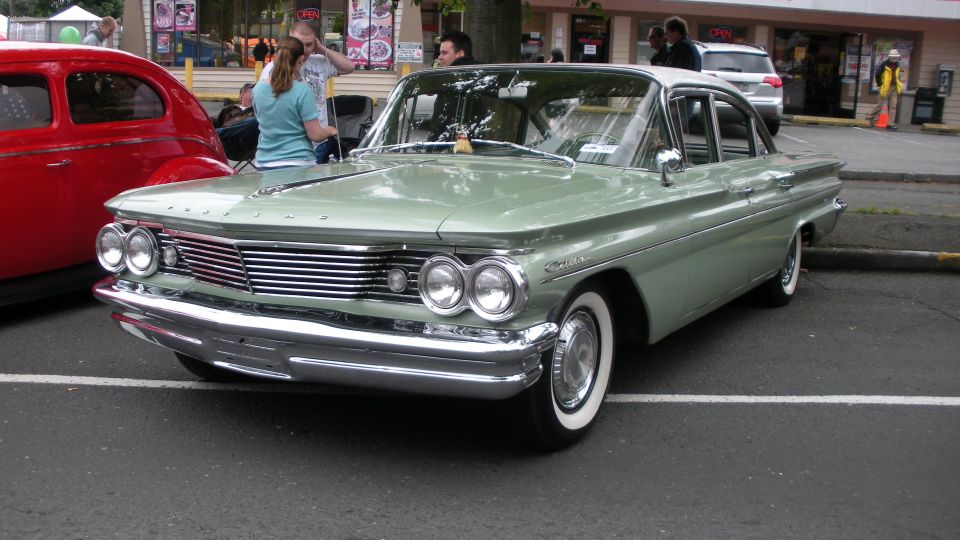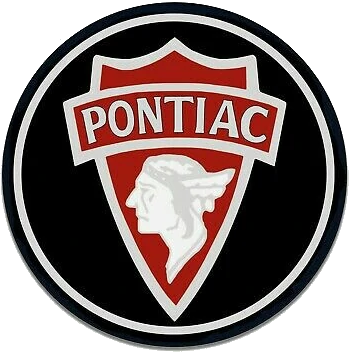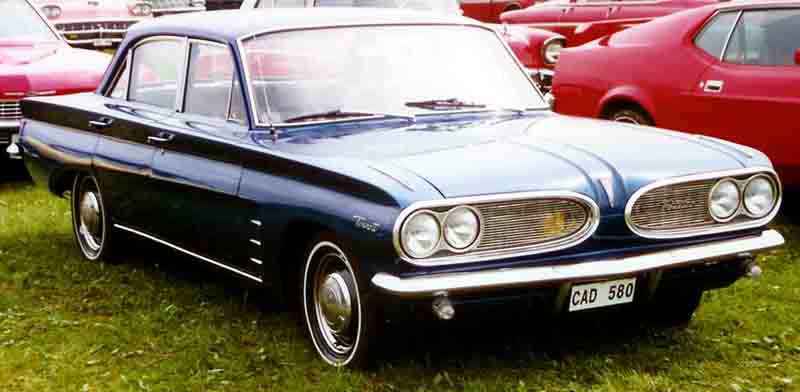|
Pontiac Catalina
The Pontiac Catalina is a full-size, junior series automobile produced by Pontiac from 1950 to 1981. Initially, the name was a trim line on hardtop body styles, first appearing in the 1950 Chieftain Eight and DeLuxe Eight lines. In 1959, it became a separate model as the "entry-level" full-size Pontiac. The Catalina was Pontiac's most popular model, available in multiple body styles, and served as the donor platform for the popular Pontiac Grand Prix, Pontiac 2+2, Pontiac Ventura, and the Pontiac Safari station wagon. When the Pontiac Tempest was introduced in 1964, lessons learned from the Catalina's introduction of the Grand Prix led to the introduction of the Pontiac GTO, to include the Pontiac V8. As a trim level (1950–1958) The name "Catalina" was first used on the 1950 Chieftain Series 25/27 hardtop, Pontiac's top trim level package at the time, and later added to the Star Chief in 1954, Pontiac's equivalent of the Chevrolet Bel Air. Originally referred to as ... [...More Info...] [...Related Items...] OR: [Wikipedia] [Google] [Baidu] |
Pontiac (automobile)
Pontiac or formally the Pontiac Motor Division of General Motors, was an American automobile brand owned, manufactured, and commercialized by General Motors. Introduced as a companion make for GM's more expensive line of Oakland automobiles, Pontiac overtook Oakland in popularity and supplanted its parent brand entirely by 1933. Sold in the United States, Canada, and Mexico by GM, in the hierarchy of GM's five divisions, it was slotted above Chevrolet, but below Oldsmobile, Buick, and Cadillac. Starting with the 1959 models, marketing was focused on selling the lifestyle that the car's ownership promised rather than the car itself. By emphasizing its "Wide Track" design, it billed itself as the "performance" division of General Motors, which "built excitement." Facing financial problems and restructuring efforts, GM announced in 2008 that it would follow the same path with Pontiac as it had with Oldsmobile in 2004. It would discontinue manufacturing and marketing vehicl ... [...More Info...] [...Related Items...] OR: [Wikipedia] [Google] [Baidu] |
Full-size Car
Full-size car—also known as large car—is a vehicle size class which originated in the United States and is used for cars larger than mid-size cars, it is the largest size class for cars. In Europe, it is known as E-segment or F-segment. After World War II, the majority of full-size cars have used the sedan and station wagon body styles, however in recent years most full-size cars have been sedans. The highest-selling full-size car nameplate is the Chevrolet Impala, sold as a full-size car from 1958 to 1986, 1994 to 1996, and from 2000 to 2020. Current definition The United States Environmental Protection Agency (EPA) ''Fuel Economy Regulations for 1977 and Later Model Year'' (dated July 1996) includes definitions for classes of automobiles. Based on the combined passenger and cargo volume, ''large cars'' (full-size cars) are defined as having an ''interior volume index'' of more than for sedan models, or for station wagons. Engines From the introduction of the Ford ... [...More Info...] [...Related Items...] OR: [Wikipedia] [Google] [Baidu] |
Cam-in-block
{{set index ...
A cam-in-block engine is where the camshaft is located in the engine block. Types of cam-in-block engines are: * F-Head Engine * Flathead engine * Overhead valve engine (the only type where the valves are above the combustion chamber) * T-head engine A T-head engine is an early type of internal combustion engine that became obsolete after World War I. It is a sidevalve engine that is distinguished from the much more common L-head by its placement of the valves. The intake valves are on on ... [...More Info...] [...Related Items...] OR: [Wikipedia] [Google] [Baidu] |
Convertible (car)
A convertible or cabriolet () is a passenger car that can be driven with or without a roof in place. The methods of retracting and storing the roof vary among eras and manufacturers. A convertible car's design allows an open-air driving experience, with the ability to provide a roof when required. A potential drawback of convertibles is their reduced structural rigidity (requiring significant engineering and modification to counteract the effects of removing a car's roof). The majority of convertible roofs are of a folding construction framework with the actual top made from cloth or other fabric. Other types of convertible roofs include retractable hardtops (often constructed from metal or plastic) and detachable hardtops (where a metal or plastic roof is manually removed and often stored in the trunk). Terminology Other terms for convertibles include cabriolet, cabrio, drop top, drophead coupé, open two-seater, open top, rag top, soft top, spider, and spyder. Consisten ... [...More Info...] [...Related Items...] OR: [Wikipedia] [Google] [Baidu] |
Pontiac Star Chief
The Pontiac Star Chief is an automobile model which was manufactured by Pontiac between 1954 and 1966. It was Pontiac's top trim package on the Pontiac Chieftain, with later generations built on longer wheelbases, and serving as the foundation platform for the Pontiac Bonneville. The car was easily identified by its chrome star trim along its sides, a feature all Star Chiefs were equipped with. __TOC__ First generation (1954) Between 1954 and 1957, the Star Chief was Pontiac's prestige model and was based on the Pontiac Chieftain. In 1954, Pontiac also introduced air conditioning with all the components under the hood, a first for the price range. Seat belts were added as options in 1956. The Star Chief was available in Deluxe and pricier Custom trim, with the top trim level hardtop called the Catalina. Prior to the introduction of the Star Chief, all Pontiacs had shared the modest wheelbase of the Chevrolet since the beginning of Pontiac. The introduction of this new premi ... [...More Info...] [...Related Items...] OR: [Wikipedia] [Google] [Baidu] |
Hardtop
A hardtop is a rigid form of automobile roof, which for modern cars is typically constructed from metal. A hardtop roof can be either fixed (i.e. not removable), detachable for separate storing or retractable within the vehicle itself. The '' pillarless hardtop'' (often referred to as simply "hardtop") is a body style of cars without a B-pillar, which are often styled to give the appearance of a convertible design. Pillarless hardtops The pillarless hardtop (abbreviated as "hardtop") is a post-World War II car body designed with no center or B-pillar styled to resemble a convertible. If window frames are present, they are designed to retract with the glass when lowered. This creates an impression of uninterrupted glass along the side of the car. Although having a rigid metal roof, the stylists sometimes make the "hardtop" cars appear to be like a convertible with its top up. Even the smaller automakers like Packard introduced two door hardtops in 1952 "as a resp ... [...More Info...] [...Related Items...] OR: [Wikipedia] [Google] [Baidu] |
Pontiac V8 Engine
The Pontiac V8 engine is a family of overhead valve 90° V8 engines manufactured by the Pontiac Division of General Motors Corporation between 1955 and 1981. The engines feature a cast-iron block and head and two valves per cylinder. Engine block and cylinder heads were cast at Saginaw Metal Casting Operations then assembled at Tonawanda Engine before delivery to Pontiac Assembly for installation. Initially marketed as a , it went on to be manufactured in displacements between and in carburated, fuel injected, and turbocharged versions. In the 1960s the popular version, which had helped establish the Pontiac GTO as a premier muscle car, was cut in half to produce an unusual, high-torque inline four economy engine, the Trophy 4. Unusual for a major automaker, Pontiac did not have the customary "small-block" and "big-block" engine families common to other GM divisions, Ford, and Chrysler. Effectively, Pontiac's V8s were all small blocks, sharing the same connecting rod le ... [...More Info...] [...Related Items...] OR: [Wikipedia] [Google] [Baidu] |
Pontiac GTO
The Pontiac GTO is an automobile that was manufactured by American automaker Pontiac from 1963 to 1974 for the 1964 to 1974 model years, and by GM's subsidiary Holden in Australia for the 2004 to 2006 model years. The first generation of the GTO is credited as popularizing the muscle car market segment in the 1960s. The Pontiac GTO is considered by some to have started the trend with all four domestic automakers offering a variety of competing models. For the 1964 and 1965 model years, the GTO was an optional package on the intermediate-sized Pontiac Lemans. The 1964 GTO vehicle identification number (VIN) started with 22, while the 1965 GTO VIN started with 237. The GTO became a separate model from 1966 to 1971 (VIN 242...). It became an optional package again for the 1972 and 1973 intermediate LeMans. For 1974, the GTO was an optional trim package on the compact-sized Ventura. The GTO was selected as the ''Motor Trend'' Car of the Year in 1968. The GTO model was revived ... [...More Info...] [...Related Items...] OR: [Wikipedia] [Google] [Baidu] |
Pontiac Tempest
The Pontiac Tempest is an automobile that was produced by Pontiac from 1960 to 1970, and again from 1987 to 1991. The Tempest was introduced as an entry-level compact in October 1960 at the Paris Auto Show for the 1961 model year. An innovative design, it shared the new unibody Y platform, GM's first, with the Buick Special/ Skylark and Oldsmobile F-85/Cutlass, and featured the "Trophy-4" four-cylinder engine with a flexible drive shaft to a two-speed rear-mounted transaxle automatic transmission. The line offered the optional LeMans trim upgrade, beginning with a few 1961 LeMans coupes and adding a performance aspect in 1962. By 1964 the Tempest, Tempest Custom and Lemans are separate trim packages on the updated GM A-body platform, and the GTO was a performance option upgrade to the LeMans for 1964 and 1965. The GTO was offered as a separate model line beginning in 1966. In Canada, Pontiac also marketed a rebadged version of the compact L-body Chevrolet Corsica under th ... [...More Info...] [...Related Items...] OR: [Wikipedia] [Google] [Baidu] |
Pontiac Safari
The Pontiac Safari is a line of station wagons that was produced by Pontiac from 1955 to 1989. Introduced as the Pontiac counterpart of the two-door Chevrolet Nomad for 1955, the nameplate was adopted across the entire full-size Pontiac station wagon range for 1957. As General Motors expanded into the intermediate, compact, and subcompact segments, the Safari nameplate saw additional use, in much the same manner as the term "estate" was used to demote luxury content in the Buick Estate and Chevrolet Caprice Estate. From the mid-1960s, simulated woodgrain trim became an exterior feature associated with the model line. The name " safari" is derived from the Swahili word ''safari'', which means ''journey,'' originally from the Arabic سفر (safar) meaning ''a journey''; the verb for "to travel" in Swahili is ''kusafiri''. As demand for full-size station wagons declined in the late 1980s, Pontiac became the first GM division to retire the body style, ending sales of the full-size ... [...More Info...] [...Related Items...] OR: [Wikipedia] [Google] [Baidu] |
Pontiac Ventura
The Pontiac Ventura was an automobile model that was produced by Pontiac. As was common practice at the time, its name was derived from Ventura, California, joining other similarly derived models such as the fellow Pontiac Catalina, the Chevrolet Malibu, and the rival Mercury Monterey. The Ventura started out as a higher content trim package on the Pontiac Catalina, and served as the inspiration for the luxury content Pontiac Grand Prix in 1962, then remained as a trim package on the Catalina until 1970. For 1971, the GM compact Chevrolet Nova was updated, and the Ventura nameplate was used until it was replaced by the front wheel drive Pontiac Phoenix. 1960–1970 The Ventura was first introduced for 1960 as a custom trim package on the Pontiac Catalina's 123-inch B-body wheelbase, and was only available as the Vista four-door hardtop, or the Sports Coupe two-door hardtop. [...More Info...] [...Related Items...] OR: [Wikipedia] [Google] [Baidu] |
Pontiac 2+2
Pontiac may refer to: *Pontiac (automobile), a car brand *Pontiac (Ottawa leader) ( – 1769), a Native American war chief Places and jurisdictions Canada *Pontiac, Quebec, a municipality **Apostolic Vicariate of Pontiac, now the Roman Catholic Diocese of Pembroke *Pontiac Regional County Municipality, Quebec, an administrative division *Pontiac (electoral district), in Quebec *Pontiac (provincial electoral district), in Quebec United States *Pontiac, Illinois **Pontiac Correctional Center, a prison in Illinois *Pontiac, Indiana *Pontiac, Kansas *Pontiac, Michigan **Pontiac Silverdome, a stadium *Pontiac, Rhode Island *Pontiac Building, a registered historic place in Chicago, Illinois *Pontiac Mills, an 1863 NRHP-listed building in Rhode Island Amtrak stations *Pontiac station (Illinois) *Pontiac Transportation Center, in Michigan Other uses *Pontiac (album), ''Pontiac'' (album), 1987, by Lyle Lovett *USS Pontiac, USS ''Pontiac'', any of several ships *Marvin Pontiac, a ficti ... [...More Info...] [...Related Items...] OR: [Wikipedia] [Google] [Baidu] |


.jpg)


.jpg)
.jpg)

.jpg)
.jpg)
